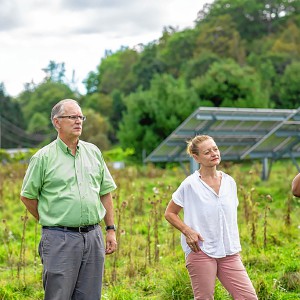Lettuce shortage: Leaves people wanting more
| Published: 12-17-2022 10:02 PM |
WHITE RIVER JUNCTION — About a month ago, Upper Valley Co-op Produce Manager Robert Lucas started noticing something strange about the price of lettuce.
Yes, inflation had been causing food prices to rise. But this was different.
“This is unprecedented,” said Lucas, who has been produce manager since 2020 and worked at the Co-op since 2009. “We’ve taken a cut in our own margin to make it accessible to our customers.”
Heads of lettuce from local suppliers usually sell for $1.99 to $2.49. Now, they’re $7.99 — and they’re not local. The Upper Valley’s main growing season has ended, shifting the Co-op to rely on suppliers from outside the region.
“Organic produce is more expensive on a good day,” Lucas said. “They really have to keep an eye on their crop so that makes it expensive to begin with.”
The shortage and rising costs have affected the Co-op’s deli, which uses lettuce in almost all of their sandwiches. The Co-op has brought in other products to address the shortage, including 5-ounce packages of lettuce and leafy greens that sell for $4.49 to $4.99, Lucas said.
There are myriad reasons for the cost increases. Food costs are already 10.6% higher than they were this time last year, according to the Bureau of Labor Statistics’ November Consumer Price Index report. The cost of lettuce is up 8.9%, among the highest increases.
According to news reports, lettuce growers in California’s Salinas Valley were hit with crop disease, a virus spread by insects. Additionally, growers have had to contend with a long-standing drought that has made conditions more difficult.
Article continues after...
Yesterday's Most Read Articles
 Zantop daughter: ‘I wish James' family the best and hope that they are able to heal’
Zantop daughter: ‘I wish James' family the best and hope that they are able to heal’
 Crowd turns out to honor late Ascutney Fire Chief Darrin Spaulding
Crowd turns out to honor late Ascutney Fire Chief Darrin Spaulding
 A Life: For Kevin Jones ‘everything was geared toward helping other people succeed’
A Life: For Kevin Jones ‘everything was geared toward helping other people succeed’
 Pick a sport and Pete DePalo’s has probably officiated it over the past 40-plus years
Pick a sport and Pete DePalo’s has probably officiated it over the past 40-plus years
 Out & About: Vermont Center for Ecostudies continues Backyard Tick Project
Out & About: Vermont Center for Ecostudies continues Backyard Tick Project
“Normally the rain can help isolate the virus, but it’s been so dry it just spreads rapidly,” said James Gordon, co-owner of Upper Valley Produce, a White River Junction-based business that delivers produce throughout the region. An acre of land in the Salinas Valley used to produce 800 cases of lettuce; this year that’s down to 150, Gordon said.
The crop disease hit around the same time of year that production shifts from California to Arizona, leaving a void. Gordon said that, once the transition is complete, prices should settle. In the meantime, distributors have turned to Mexico, but growers there cannot keep up with demand, which has caused those prices to rise.
Produce is more expensive across the board: The price of diesel fuel is higher than it was a year ago, and there’s also a shortage of truck drivers, making transport more expensive. Lettuce has been impacted more than other vegetables because of the virus.
“It’s dramatic,” Gordon said, adding that he’s never seen anything like this in his 30 years in the produce business.
While area farms do grow lettuce, it is more leafy greens and less iceberg lettuce, he said. The Northeast also has a shorter growing season, and farms are smaller than they are in the West.
Restaurants also have felt the pinch. Anthony Barnett, owner of Blue Sky Restaurant Group, which includes Jesse’s Steaks, Seafood and Tavern, Molly’s Restaurant and Bar, Snax and Dunk’s Sports Grill, said that, while most produce prices have risen, lettuce is an outlier in the size of the increase. Last December, a case of iceberg lettuce cost $39.25; this December it cost $141.48. Romaine lettuce doubled from $22.26 a case to $44.01.
“It’s not uncommon for there to be a couple categories of specific items that have a higher price, but this is exceptionally bad,” Barnett said. “I’ve never seen it quite like this.”
While the business has not been faced with any shortages, the lettuce that it has managed to get is not what it is used to be.
“Lots of time when it gets more expensive, the quality is actually worse,” Barnett said. Usually, the restaurants can get 95% yield out of a head of lettuce — meaning the amount of an individual head that can be used. Currently, the yield is around 80% and the outer leaves are often in poor condition.
“There’s been times when we just have substituted one produce for another in order to not be out,” he said.
For example, the business has been using more romaine hearts in its salads.
“Which is great if you like a crunchier Caesar salad,” Barnett said. “Some people like it leafier, so they’d be disappointed.”
There can be a downside to substitutions, and it’s not just the potential for a different taste or texture. It’s the cost.
“People are getting creative. There’s other things they can do,” Gordon said. “But once everybody starts getting creative it starts putting demand on other varieties and it drives the prices up on those varieties as well.”
Lettuce isn’t the only crop that is seeing prices increase. Lucas said broccoli, which typically sells for $1.99 to $2.49 per pound, is now around $4.99 per pound. Cauliflower, usually $2.49 a pound, is now $4.99.
In some ways, the cost of lettuce has been easier to manage than other price increases, Barnett said. A couple of months ago, beef and chicken prices rose.
“It’s better to see produce high than those other ones,” he said.
Gordon offered this advice for consumers: “When you’re at a grocery store, you have to look at the product that looks the best to you and be open-minded to a different variety of products,” he said.
Liz Sauchelli can be reached at esauchelli@vnews.com or 603-727-3221.

 Upper Valley winter shelters kept dozens warm and dry
Upper Valley winter shelters kept dozens warm and dry Owner of Friesian horse facility ordered to pay care costs for seized animals
Owner of Friesian horse facility ordered to pay care costs for seized animals
